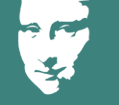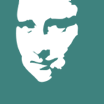| 

| Black Geometry | 
| David Ter-Oganian July 8-20, 2009 July 8-20, 2009 |
| | David Ter-Oganian has so successfully and consistently developed the theme of black that the colour has virtually taken over as the artist's signature.
One of Ter-Oganian's first major works in this area was the "Wall of Overturned Cars", shown at the "Us and Them" exhibition held by the Guelman Gallery in 2003. The theme of the exhibition was politics or, more precisely, the question of political orientation and the choice between the right and left wings in the contemporary situation. The left wing was opened by Ter-Oganian's tapestry of a hundred A4 sheets with silhouettes of mangled, smoking cars. His work was remarkable not only for its ideological robustness, but also for the formal aspect, depicting the cars piecemeal, each one as a concrete battle trophy.
Black was deprived of its symbolical meaning, used to designate such examples of primary matter as earth, coal, iron or oil. With the help of the colour, the image became intensely material, heavy and non-metaphoric. Black also unified all the items in their objective essence, outside name, mark, sort or brand.
This was the basis for the aesthetic paradox created by David Ter-Oganian – a combination of using black abstract silhouette forms and approaching the object as a singular phenomenon. The artist's black silhouettes of bombs, cars and human figures holding banners embody a pre-individual concreteness – what Gilles Deleuze called "singularity." Independent of whether it represents an animate or inanimate object, each unit of Ter-Oganian's black series is a bud or offshoot of a powerful, revolutionary fungus growing in the body of modern capitalism. Forming multitudes that do not submit to rigid structures, these singularities confront the organisations governed by hierarchic, authoritarian laws.
In his "Black Geometry" series, David Ter-Oganian follows the principle of "one canvas – one image." The images selected by the artist, however, have a recognisable genealogy. They are a form of readymade – the outlines of African countries, created as a result of the scramble for the continent undertaken by the major world powers at the turn of the century. This signalled the start of the campaigns of imperialist expansionism, while the contours of the countries, drawn with the help of a ruler, reflect the straightforward desires of early colonialism. These wishes clearly ran counter to the topographical conditions and natural givens of the African continent – explaining the ugliness of the silhouettes and their incongruity to traditional cartography.
The subject-matter chosen by the artist contradicts the established artistic discourse linking geometry to metaphysics. Like lopped-off pieces of cake, his mutilated geographic subjects have nothing in common with the concepts of order and logic – and even less with pre-preparation and higher legality, as we climb the steps of metaphysics, just as all adherents of geometry did before us.
The artist does not lead the viewer downwards, but into the depths of the physiology of stupidity and malevolence. As we descend "from the carnivorous to the herbivorous," we encounter irregular botanic forms, far removed from any geometry, as described by Gilles Deleuze. * On the map, however, the irregular pear-shaped and pointed outlines of the continent's natural borders acquire the sense of a higher order. Deleuze's triad of the "stupidity, malevolence and madness" of tyranny is personified by geometry – what we call European culture.
-
* "The internal process of digestion is more profound than the external gesture of attack or voracious movement: stupidity with peristaltic movements. That is why tyrants have the heads not only of beasts, but also of pears, cauliflowers or potatoes" (Gilles Deleuze, Difference and Repetition, New York, 1994, p. 151).
| | 

|
|





